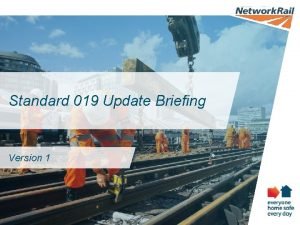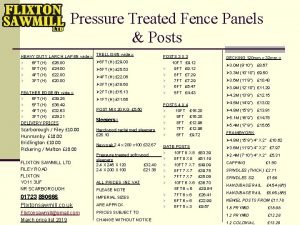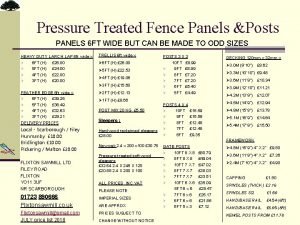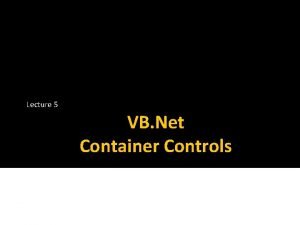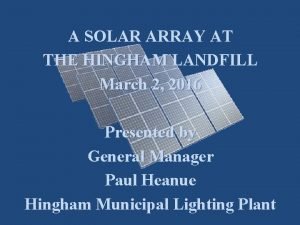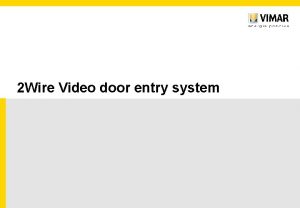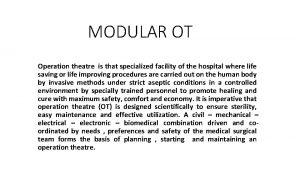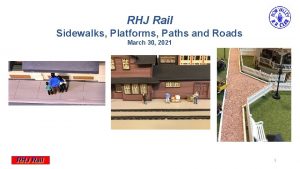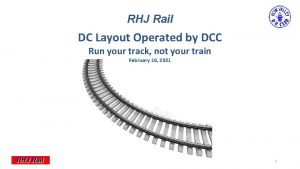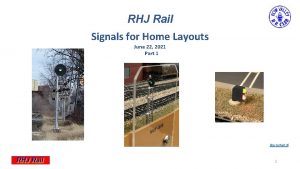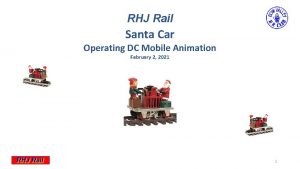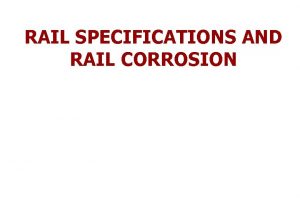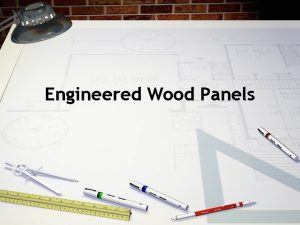RHJ Rail Control Panels Overview March 2 2021















- Slides: 15

RHJ Rail Control Panels - Overview March 2, 2021 1

Definition Ø What is a control panel? § A physical means of observing, and possibly modifying, the state of a layout or part thereof Ø What can be observed? § § § Layout configuration, either schematically, realistically, or somewhere in between The location and position of some or all of the turnouts on the layout The location, and possibly direction of travel, of some or all trains on the layout The status (occupied or clear) of some or all track segments (blocks) on the layout Other aspects of the layout including signal states, locomotives in use, some accessories Ø Important to name locations: § Cities, towns, yards, industrial areas, sidings, junctions, passing locations, everything 2

Use and Type Ø How are different types of control panels used? § § § § To imitate as closely as possible the real thing for the era and railroad being modeled To represent all or part of the layout in some abbreviated form To show the entire layout as one big picture and display certain aspects To show a section of the layout such as a yard, station tracks, industrial area To observe the status of the layout, for instance turnout position, block occupancy To modify certain aspects of the layout, most commonly turnout positions To measure, test, and program locomotives and similar mobile powered equipment 3

Use and Type Ø What can be used to determine the type of panel? § The role the owner/operator wants to play: § Locomotive engineer § Switchman § Dispatcher § Observer § The layout size and accessibility § The space available § The width of aisles: narrow aisles may mean flatter or smaller panels § The type of layout operation used § The vantage point of operators 4

Control Panel Examples Control panel for small layout segment Prototypical Control Panel (computer display) Drawer-mounted panel for turnouts only 5

Reasons for Control Panels Ø To view, monitor or control the whole layout or certain localized sections of it Ø To change the state of certain layout components Ø To facilitate train or locomotive movements or scheduled actions Ø To set track switches for planned or required operations Ø To operate the model railroad layout in a manner consistent with the owner’s preferences § To simulate protype operations to the degree the owner wishes § To provide some degree of remote control § To provide some degree of layout monitoring § To operate difficult-to-access track switches and other components § To provide a global or localized view of the layout with items critical for operation and control § To operate trains, perhaps (many control panels leave train operation to locomotive engineers) 6

Locations of Control Panels Ø Fascia-mounted in some manner Ø Applied directly on flat fascia with indictors and controls for local areas Ø Hinged from layout frame or fascia; possibly drawer-mounted where space is at a premium Ø Solidly attached to fascia Ø Free-standing Ø Computer-based on one or more screens Ø Some large layouts have computer-based control panels for dispatcher in a separate room § Requires multiple operators playing different roles 7

Control Panel Examples Fascia-supported panel for layout segment Panel for entire layout or large yard section Fascia-applied panel for layout segment 8

Types of Control Panels Ø Physical § Usually constructed of wood frame, paneling, surface with diagram and components § Diagram or schematic may be painted, taped, or printed with a clear overlay § Components typically include toggle switches and LED indicators for turnouts § May contain signal indications, block occupancy indications, status of other components § Usually laid out so that most tracks are horizontal, with indicators and switches as needed Ø Virtual § Displayed on one or more computer screens § May be an accurate representation of a prototype panel, a schematic diagram, a combination, or custom design § May be constructed from software available, either commercial, free, or custom § May be used for observation only or to operate designated components 9

Scope of Control Panels Ø More suited to fixed layouts (home, club); difficult for interchangeable modular layouts Ø Whole layout § Includes entire layout with some or all functions Ø Local area (may have several) § Yard § Station or urban area § Industrial area § Subdivisions off main line § Switching sections Ø Specialized § Maintenance panel 10

Scope of Control Panels Ø Components may include: § § § § Schematic diagram, realistic to some degree Indicators for turnout positions Switches to control turnouts Indicators for block occupancy Switches to isolate certain sections Signal indications Turntable and other specialized controls Ø Physical panels typically use LED indicators, toggle switches Ø Computer panels typically use on-screen display for components; may react to touch-screen commands (rare) or keyboard or mouse input 11

Control Panel Examples Whole layout control panel Includes turnout control and indication, block control, block occupancy and direction. DC operation (2 trains) and (originally) voltage and amp measurement (weighs 7 lbs. ) 12

RHJ Rail Maintenance Panel 13

RHJ Rail Maintenance Panel Ø Maintenance Panel includes § DCC ü Digitrax throttle ü Digitrax test running, programming ü ESU programmer (requires computer) § DC ü Voltage-controlled track ü Measures voltage, amps Ø Measures DC amps at 12 VDC under load § Load can be ü Running free ü Running with wheel slip ü Running with wheels stalled (used for matching rated load of decoders) Ø Useful for programming, reading CVs, wheel cleaning, checking clearances, minor adjustments Ø Uses separate track; does not connect to main layout 14

Follow-Up Ø Thanks for your interest Ø Any questions can be directed to RHJ Rail Ø More to come. . . 15
 Anthem of poland
Anthem of poland Current events quiz
Current events quiz March 5 2021
March 5 2021 019 railway standard
019 railway standard Solar panel table
Solar panel table Npua panels
Npua panels Solar panels monson
Solar panels monson Pressure treated fence panels
Pressure treated fence panels Precast concrete veneer
Precast concrete veneer Wholesale solar power battery
Wholesale solar power battery Pressure treated fence panels
Pressure treated fence panels Status strip in vb.net
Status strip in vb.net Hiten roofing
Hiten roofing Solar panels hingham
Solar panels hingham 2-wires door entry system design
2-wires door entry system design Modular ot flooring
Modular ot flooring



